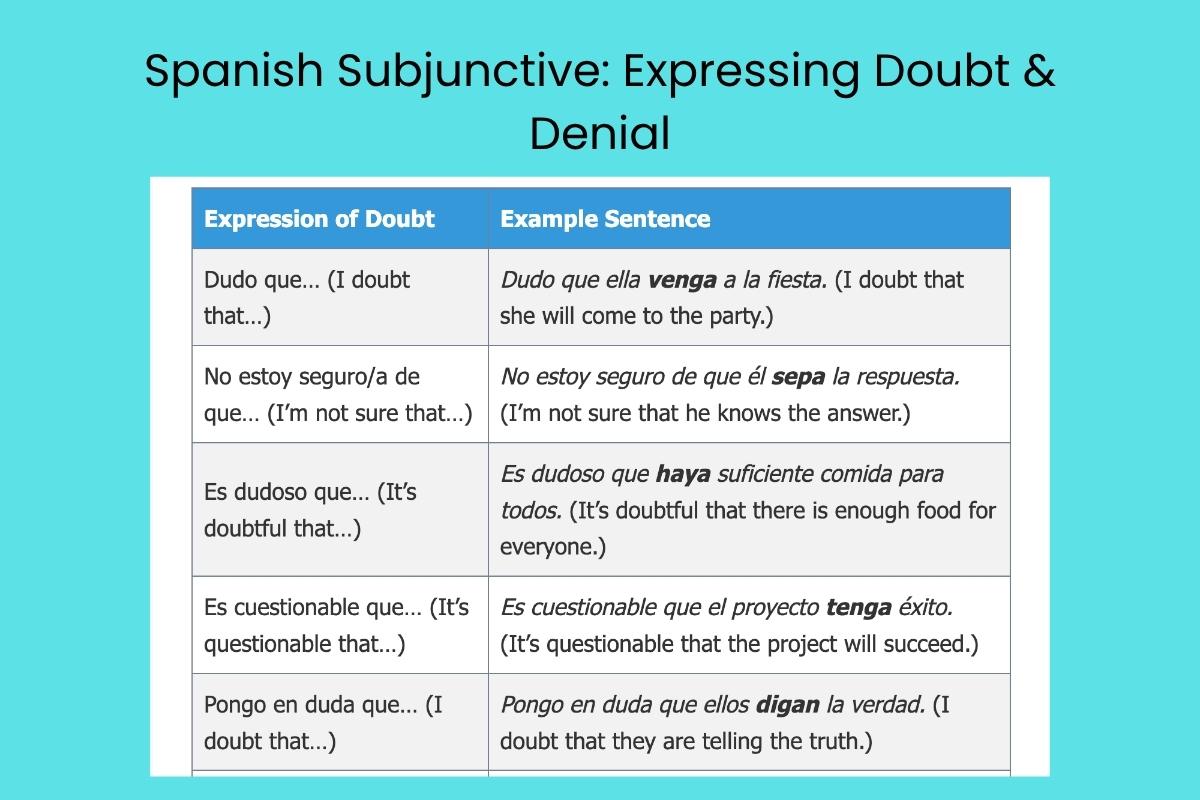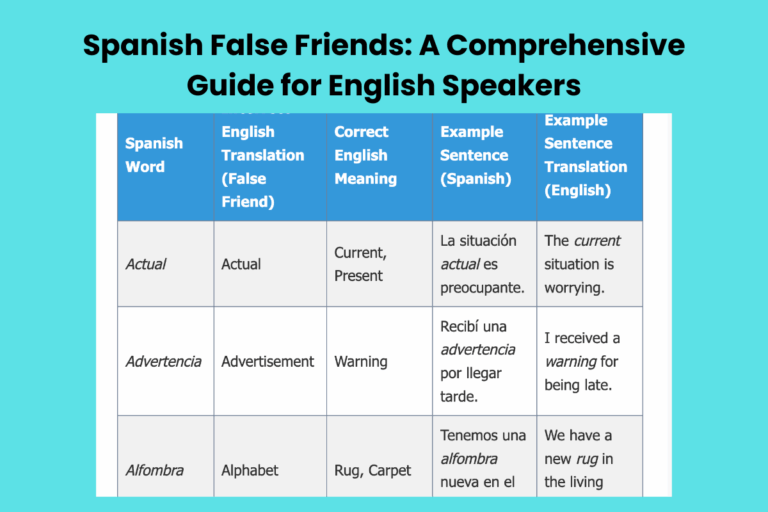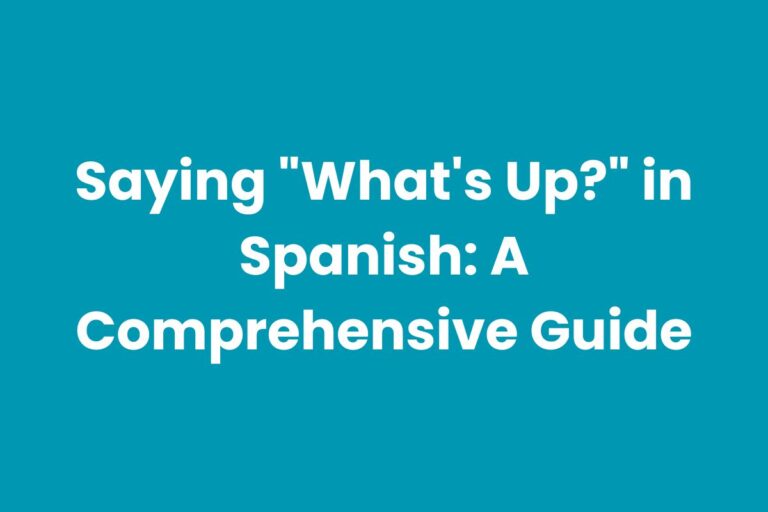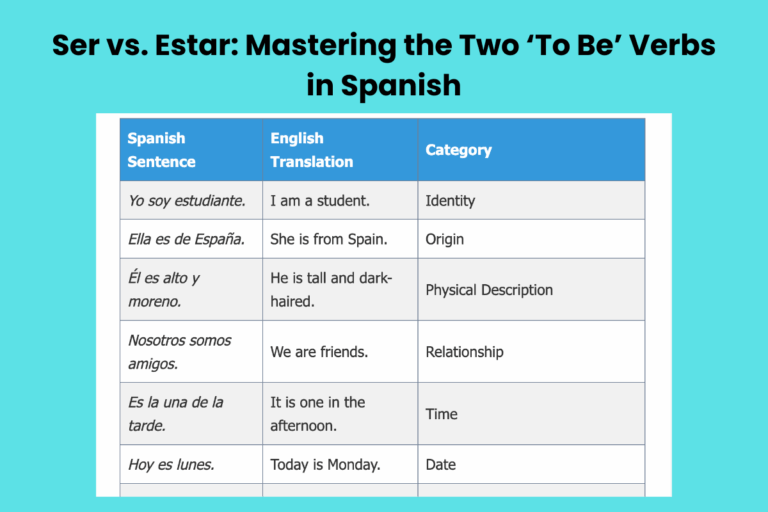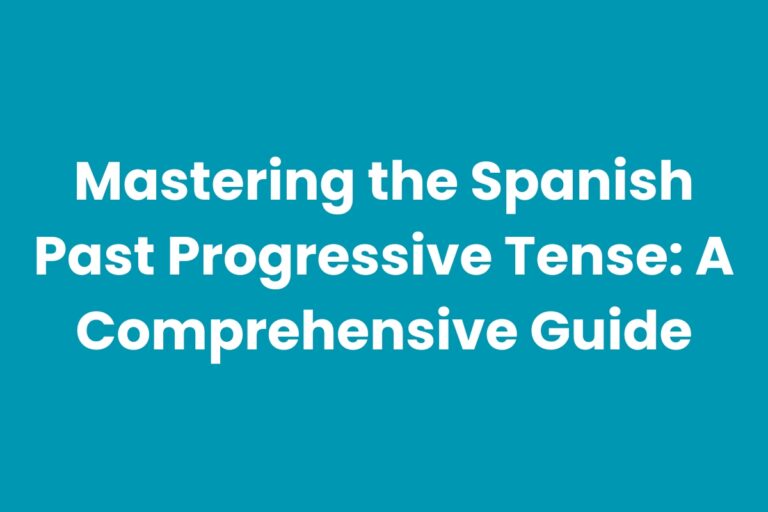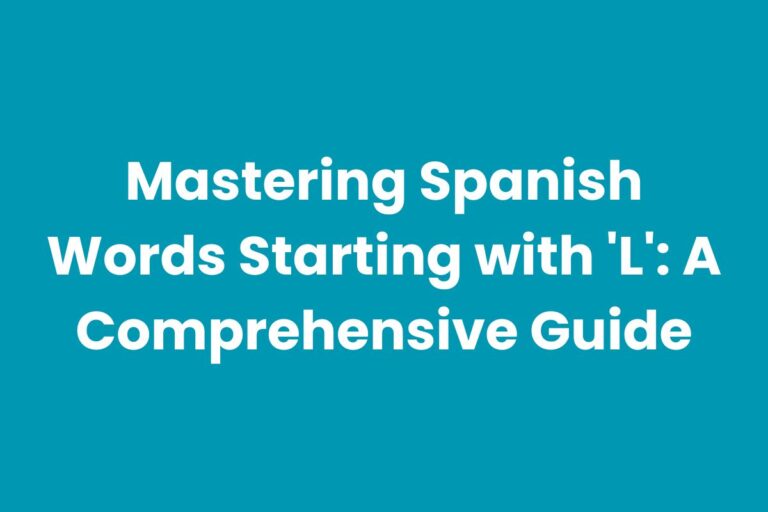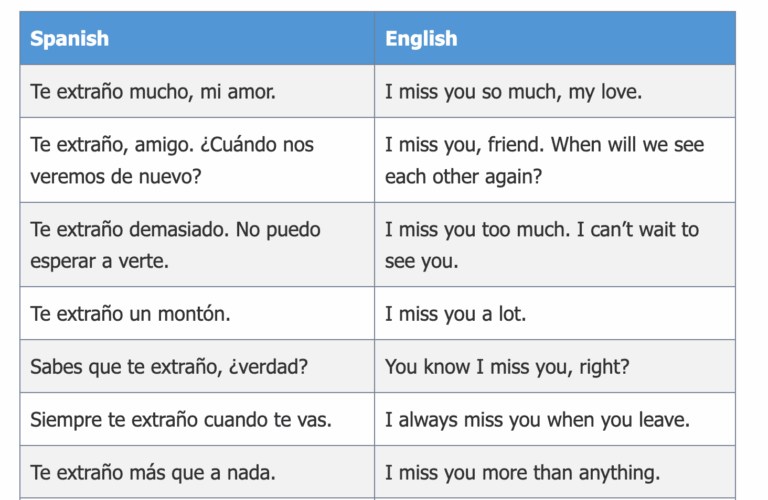Spanish Subjunctive: Expressing Doubt & Denial
Mastering the Spanish subjunctive mood is crucial for expressing nuanced opinions, emotions, and uncertainties. One of its most important applications lies in expressing doubt and denial.
Understanding when and how to use the subjunctive in these contexts allows you to convey skepticism, disbelief, or a lack of certainty, adding depth and accuracy to your Spanish communication. This article provides a comprehensive guide to using the Spanish subjunctive with expressions of doubt and denial, equipping you with the knowledge and practice you need to confidently navigate this challenging aspect of Spanish grammar.
This guide will benefit students of all levels, from intermediate learners aiming to refine their skills to advanced speakers seeking to perfect their command of the language.
Definition of the Subjunctive in Doubt and Denial
The subjunctive mood in Spanish is used to express subjectivity, uncertainty, emotions, desires, and doubt. When it comes to doubt and denial, the subjunctive is triggered by specific verbs and expressions that indicate a lack of certainty or a contradiction of a factual statement.
The subjunctive doesn’t describe reality; instead, it reflects the speaker’s perspective, opinion, or emotional state regarding the likelihood or truthfulness of an event. This contrasts with the indicative mood, which is used to state facts and certainties.
In essence, the subjunctive signals that something is not presented as a confirmed, objective truth.
The subjunctive is crucial for conveying subtle nuances in Spanish. Using the indicative where the subjunctive is required can drastically alter the meaning of a sentence, making it sound assertive when doubt or uncertainty is intended.
Conversely, using the subjunctive incorrectly can make your speech sound unnatural or grammatically incorrect. Therefore, a solid understanding of subjunctive usage with doubt and denial is essential for effective and accurate communication in Spanish.
Structural Breakdown
The typical structure for expressing doubt and denial using the subjunctive involves a main clause with a verb or expression of doubt or denial, followed by a subordinate clause introduced by the conjunction “que” (that). The verb in the subordinate clause is conjugated in the subjunctive mood.
This structure creates a dependent relationship between the two clauses, where the subjunctive mood in the second clause is dictated by the expression of doubt or denial in the first clause. Understanding this structure is key to constructing grammatically correct sentences expressing these concepts.
The basic formula is as follows: (Main Clause: Doubt/Denial Expression) + que + (Subordinate Clause: Subjunctive Verb). The main clause sets the stage by introducing the element of doubt or denial. The conjunction “que” acts as a bridge, connecting the main clause to the subordinate clause, where the subjunctive verb expresses the uncertain or denied action or state. Let’s illustrate this with an example: No creo que él venga (I don’t believe that he is coming). Here, “No creo” (I don’t believe) is the main clause expressing denial, “que” is the conjunction, and “venga” (is coming) is the subjunctive verb.
Common Verbs and Expressions
Certain verbs and expressions frequently trigger the subjunctive mood when expressing doubt and denial. These words act as signals, indicating that the information that follows is not presented as a certainty.
Recognizing these triggers is a crucial step in mastering the subjunctive. These verbs and expressions can be categorized into those expressing doubt, denial, or uncertainty.
- Doubt: Dudar (to doubt), No estar seguro/a de (to not be sure), Es dudoso (it is doubtful), Es cuestionable (it is questionable).
- Denial: Negar (to deny), No creer (to not believe), No pensar (to not think), No es cierto (it is not certain), No es verdad (it is not true).
- Uncertainty: No es evidente (it is not evident), No parece (it doesn’t seem), Es posible (it is possible), Puede ser (it may be).
Understanding the specific meaning and nuance of each verb and expression is important for choosing the correct one to convey your intended message. For instance, “dudar” implies a more direct sense of doubt than “no estar seguro/a de,” which simply means “to not be sure.” Similarly, “negar” carries a stronger connotation of denial than “no creer,” which can sometimes simply indicate a lack of belief without necessarily implying active denial.
Mastering these nuances will help you use the subjunctive with greater precision and confidence.
Examples of Subjunctive with Doubt and Denial
The following sections provide extensive examples of how the subjunctive is used with different expressions of doubt, denial, and uncertainty. These examples are categorized to help you understand the specific contexts in which each type of expression triggers the subjunctive.
Expressions of Doubt
These examples demonstrate the use of the subjunctive after verbs and expressions that indicate doubt. Notice how the subjunctive in the subordinate clause reflects the uncertainty conveyed by the main clause.
The following table showcases examples of using the Spanish subjunctive with expressions of doubt. Each row provides a sentence using an expression of doubt followed by a subjunctive verb.
| Expression of Doubt | Example Sentence |
|---|---|
| Dudo que… (I doubt that…) | Dudo que ella venga a la fiesta. (I doubt that she will come to the party.) |
| No estoy seguro/a de que… (I’m not sure that…) | No estoy seguro de que él sepa la respuesta. (I’m not sure that he knows the answer.) |
| Es dudoso que… (It’s doubtful that…) | Es dudoso que haya suficiente comida para todos. (It’s doubtful that there is enough food for everyone.) |
| Es cuestionable que… (It’s questionable that…) | Es cuestionable que el proyecto tenga éxito. (It’s questionable that the project will succeed.) |
| Pongo en duda que… (I doubt that…) | Pongo en duda que ellos digan la verdad. (I doubt that they are telling the truth.) |
| No creo que… (I don’t believe that…) | No creo que sea una buena idea. (I don’t believe that it’s a good idea.) |
| Dudo que… (I doubt that…) | Dudo que hayan terminado el trabajo. (I doubt that they have finished the work.) |
| No estoy seguro/a de que… (I’m not sure that…) | No estoy seguro de que vayan a venir. (I’m not sure that they are going to come.) |
| Es dudoso que… (It’s doubtful that…) | Es dudoso que podamos ir. (It’s doubtful that we can go.) |
| Es cuestionable que… (It’s questionable that…) | Es cuestionable que quieran ayudarnos. (It’s questionable that they want to help us.) |
| Pongo en duda que… (I doubt that…) | Pongo en duda que tengan razón. (I doubt that they are right.) |
| No creo que… (I don’t believe that…) | No creo que sea posible. (I don’t believe that it’s possible.) |
| Dudo que… (I doubt that…) | Dudo que tenga tiempo para verte. (I doubt that I have time to see you.) |
| No estoy seguro/a de que… (I’m not sure that…) | No estoy seguro de que sea correcto. (I’m not sure that it is correct.) |
| Es dudoso que… (It’s doubtful that…) | Es dudoso que sepamos la respuesta. (It’s doubtful that we know the answer.) |
| Es cuestionable que… (It’s questionable that…) | Es cuestionable que puedan resolver el problema. (It’s questionable that they can solve the problem.) |
| Pongo en duda que… (I doubt that…) | Pongo en duda que estén diciendo la verdad. (I doubt that they are telling the truth.) |
| No creo que… (I don’t believe that…) | No creo que sea necesario. (I don’t believe that it is necessary.) |
| Dudo que… (I doubt that…) | Dudo que entiendan el problema. (I doubt that they understand the problem.) |
| No estoy seguro/a de que… (I’m not sure that…) | No estoy seguro de que esté lloviendo. (I’m not sure that it is raining.) |
| Es dudoso que… (It’s doubtful that…) | Es dudoso que lleguen a tiempo. (It’s doubtful that they will arrive on time.) |
| Es cuestionable que… (It’s questionable that…) | Es cuestionable que sea justo. (It’s questionable that it is fair.) |
| Pongo en duda que… (I doubt that…) | Pongo en duda que sepan lo que hacen. (I doubt that they know what they are doing.) |
| No creo que… (I don’t believe that…) | No creo que sea verdad. (I don’t believe that it is true.) |
Expressions of Denial
These examples illustrate the use of the subjunctive after verbs and expressions that indicate denial. Similar to expressions of doubt, these expressions negate the certainty of the following statement, thus requiring the subjunctive.
The following table showcases examples of using the Spanish subjunctive with expressions of denial. Each row provides a sentence using an expression of denial followed by a subjunctive verb.
| Expression of Denial | Example Sentence |
|---|---|
| No niego que… (I don’t deny that…) | No niego que sea importante. (I don’t deny that it’s important.) |
| No creo que… (I don’t believe that…) | No creo que él tenga razón. (I don’t believe that he is right.) |
| No pienso que… (I don’t think that…) | No pienso que ella esté enferma. (I don’t think that she is sick.) |
| No es cierto que… (It’s not certain that…) | No es cierto que haya una solución fácil. (It’s not certain that there is an easy solution.) |
| No es verdad que… (It’s not true that…) | No es verdad que ellos sean culpables. (It’s not true that they are guilty.) |
| Niego que… (I deny that…) | Niego que sea mi responsabilidad. (I deny that it’s my responsibility.) |
| No creo que… (I don’t believe that…) | No creo que venga mañana. (I don’t believe that he/she is coming tomorrow.) |
| No pienso que… (I don’t think that…) | No pienso que sea una buena idea. (I don’t think that it is a good idea.) |
| No es cierto que… (It’s not certain that…) | No es cierto que tengan el dinero. (It’s not certain that they have the money.) |
| No es verdad que… (It’s not true that…) | No es verdad que sepa la verdad. (It’s not true that he/she knows the truth.) |
| Niego que… (I deny that…) | Niego que haya pasado eso. (I deny that that happened.) |
| No creo que… (I don’t believe that…) | No creo que sea tan fácil. (I don’t believe that it is so easy.) |
| No pienso que… (I don’t think that…) | No pienso que esté bien. (I don’t think that it is right.) |
| No es cierto que… (It’s not certain that…) | No es cierto que puedan hacerlo. (It’s not certain that they can do it.) |
| No es verdad que… (It’s not true that…) | No es verdad que quieran venir. (It’s not true that they want to come.) |
| No niego que… (I don’t deny that…) | No niego que sea posible. (I don’t deny that it is possible.) |
| No creo que… (I don’t believe that…) | No creo que estén listos. (I don’t believe that they are ready.) |
| No pienso que… (I don’t think that…) | No pienso que necesiten ayuda. (I don’t think that they need help.) |
| No es cierto que… (It’s not certain that…) | No es cierto que vayan a ganar. (It’s not certain that they are going to win.) |
| No es verdad que… (It’s not true that…) | No es verdad que tengan la solución. (It’s not true that they have the solution.) |
Expressions of Uncertainty
These examples demonstrate how expressions of uncertainty, while not explicitly denying or doubting something, still create enough ambiguity to warrant the use of the subjunctive.
The following table showcases examples of using the Spanish subjunctive with expressions of uncertainty. Each row provides a sentence using an expression of uncertainty followed by a subjunctive verb.
| Expression of Uncertainty | Example Sentence |
|---|---|
| No es evidente que… (It’s not evident that…) | No es evidente que haya una conexión. (It’s not evident that there is a connection.) |
| No parece que… (It doesn’t seem that…) | No parece que él esté interesado. (It doesn’t seem that he is interested.) |
| Es posible que… (It’s possible that…) | Es posible que llueva mañana. (It’s possible that it will rain tomorrow.) |
| Puede ser que… (It may be that…) | Puede ser que ella llegue tarde. (It may be that she will arrive late.) |
| Es improbable que… (It’s improbable that…) | Es improbable que ganemos el partido. (It’s improbable that we will win the game.) |
| No es evidente que… (It’s not evident that…) | No es evidente que sepan la verdad. (It’s not evident that they know the truth.) |
| No parece que… (It doesn’t seem that…) | No parece que vayan a venir. (It doesn’t seem that they are going to come.) |
| Es posible que… (It’s possible that…) | Es posible que haya un error. (It’s possible that there is an error.) |
| Puede ser que… (It may be that…) | Puede ser que necesitemos ayuda. (It may be that we need help.) |
| Es improbable que… (It’s improbable that…) | Es improbable que tengan éxito. (It’s improbable that they will be successful.) |
| No es evidente que… (It’s not evident that…) | No es evidente que esté funcionando. (It’s not evident that it is working.) |
| No parece que… (It doesn’t seem that…) | No parece que quieran escuchar. (It doesn’t seem that they want to listen.) |
| Es posible que… (It’s possible that…) | Es posible que estemos equivocados. (It’s possible that we are wrong.) |
| Puede ser que… (It may be that…) | Puede ser que haya una solución. (It may be that there is a solution.) |
| Es improbable que… (It’s improbable that…) | Es improbable que puedan terminar a tiempo. (It’s improbable that they can finish on time.) |
| No es evidente que… (It’s not evident that…) | No es evidente que sea necesario. (It’s not evident that it is necessary.) |
| No parece que… (It doesn’t seem that…) | No parece que les guste. (It doesn’t seem that they like it.) |
| Es posible que… (It’s possible that…) | Es posible que vayan a cambiarlo. (It’s possible that they are going to change it.) |
| Puede ser que… (It may be that…) | Puede ser que tenga razón. (It may be that he/she is right.) |
| Es improbable que… (It’s improbable that…) | Es improbable que sepan la respuesta. (It’s improbable that they know the answer.) |
Usage Rules
Several key rules govern the use of the subjunctive with expressions of doubt and denial. These rules dictate when the subjunctive is required, when it is not, and how to handle exceptions.
Mastering these rules is essential for using the subjunctive accurately and naturally.
Affirmative vs. Negative
One of the most important rules is that affirmative statements expressing belief or certainty typically trigger the indicative mood, while their negative counterparts trigger the subjunctive. For example, “Creo que él viene” (I believe that he is coming) uses the indicative because it expresses a belief.
However, “No creo que él venga” (I don’t believe that he is coming) uses the subjunctive because it expresses a lack of belief or doubt.
This rule applies to verbs like creer (to believe), pensar (to think), estar seguro/a (to be sure), and opinar (to opine). When these verbs are used in the affirmative, they are usually followed by the indicative. When they are negated, they are followed by the subjunctive. This shift in mood reflects the change in the speaker’s level of certainty.
Indirect Questions
Indirect questions that express doubt or uncertainty also often trigger the subjunctive. An indirect question is a question embedded within a statement.
For example, “No sé si venga” (I don’t know if he is coming) is an indirect question expressing uncertainty, and therefore, it uses the subjunctive. The phrase “No sé si” (I don’t know if) introduces the element of doubt, leading to the use of the subjunctive in the embedded question.
Other phrases that introduce indirect questions and trigger the subjunctive include Dudo si… (I doubt if…), No estoy seguro/a de si… (I’m not sure if…), and Me pregunto si… (I wonder if…). In these cases, the subjunctive reflects the speaker’s uncertainty about the answer to the question.
Exceptions to the Rule
While the general rule is that negative expressions of belief and doubt trigger the subjunctive, there are exceptions. One notable exception involves using these expressions rhetorically to strongly assert a point.
For example, if someone says “No creo que sea una buena idea!” (I don’t believe that it’s a good idea!), emphasizing “no creo,” they might actually be asserting their strong opposition, in which case the indicative could be used. However, this is a more nuanced usage and should be approached with caution by learners.
Another exception involves using expressions of doubt or denial in questions. In this case, the indicative is often used.
For example, “¿No crees que tiene razón?” (Don’t you think that he is right?) typically uses the indicative because it is seeking confirmation rather than expressing genuine doubt. These exceptions highlight the complexities of the subjunctive and the importance of understanding the context in which it is used.
Common Mistakes
One of the most common mistakes learners make is using the indicative after expressions of doubt and denial. For example, saying “No creo que él viene” (incorrect) instead of “No creo que él venga” (correct).
This error stems from a misunderstanding of the subjunctive’s role in expressing uncertainty. It’s crucial to remember that these expressions require the subjunctive to accurately convey the intended meaning.
Another common mistake is using the subjunctive in affirmative sentences where the indicative is required. For example, saying “Creo que él venga” (incorrect) instead of “Creo que él viene” (correct).
This error often arises from overgeneralizing the rule that the subjunctive is used after “creer” and “pensar.” Remember that the subjunctive is only triggered when these verbs are used in the negative or to express doubt.
The following table showcases common mistakes made when using the Spanish subjunctive with expressions of doubt and denial, along with the corrections.
| Incorrect | Correct | Explanation |
|---|---|---|
| No creo que él viene. | No creo que él venga. | The subjunctive “venga” is required after the negative expression “no creo que.” |
| Dudo que ella tiene razón. | Dudo que ella tenga razón. | The subjunctive “tenga” is required after the expression of doubt “dudo que.” |
| No estoy seguro de que él sabe la verdad. | No estoy seguro de que él sepa la verdad. | The subjunctive “sepa” is required after the expression “no estoy seguro de que.” |
| Es dudoso que hay suficiente comida. | Es dudoso que haya suficiente comida. | The subjunctive “haya” is required after the expression “es dudoso que.” |
| Niego que es mi culpa. | Niego que sea mi culpa. | The subjunctive “sea” is required after the expression of denial “niego que.” |
| Creo que él venga. | Creo que él viene. | The indicative “viene” is required after the affirmative expression “creo que.” |
| Pienso que ella esté aquí. | Pienso que ella está aquí. | The indicative “está” is required after the affirmative expression “pienso que.” |
Practice Exercises
The following exercises will help you practice using the subjunctive with expressions of doubt and denial. These exercises cover various aspects of the topic, from filling in the blanks to transforming sentences and correcting errors.
Exercise 1: Fill in the Blanks
Fill in the blanks with the correct subjunctive form of the verb in parentheses.
- No creo que ellos ________ (venir) mañana.
- Dudo que ________ (haber) suficiente tiempo.
- No estoy seguro de que ella ________ (saber) la respuesta.
- Es dudoso que ________ (ser) posible.
- Niego que yo ________ (hacer) eso.
- No pienso que él ________ (estar) enfermo.
- Es cuestionable que ellos ________ (querer) ayudar.
- No es cierto que ________ (tener) el dinero.
- Puede ser que ________ (llover) mañana.
- No parece que ________ (funcionar) bien.
Answer Key:
- vengan
- haya
- sepa
- sea
- haga
- esté
- quieran
- tengan
- llueva
- funcione
Exercise 2: Sentence Transformation
Transform the following sentences to express doubt or denial using the subjunctive.
- Creo que él tiene razón. (Transform using “No creo que…”)
- Estoy seguro de que ella sabe la verdad. (Transform using “No estoy seguro de que…”)
- Es evidente que hay una solución. (Transform using “No es evidente que…”)
- Pienso que es una buena idea. (Transform using “No pienso que…”)
- Es verdad que ellos son culpables. (Transform using “No es verdad que…”)
- Sé que ella va a venir. (Transform using “Dudo que…”)
- Estoy seguro de que ellos pueden hacerlo. (Transform using “No estoy seguro de que…”)
- Es cierto que él está trabajando. (Transform using “No es cierto que…”)
- Pienso que es necesario. (Transform using “No pienso que…”)
- Es evidente que ellos quieren ir. (Transform using “No es evidente que…”)
Answer Key:
- No creo que él tenga razón.
- No estoy seguro de que ella sepa la verdad.
- No es evidente que haya una solución.
- No pienso que sea una buena idea.
- No es verdad que ellos sean culpables.
- Dudo que ella venga.
- No estoy seguro de que ellos puedan hacerlo.
- No es cierto que él esté trabajando.
- No pienso que sea necesario.
- No es evidente que ellos quieran ir.
Exercise 3: Error Correction
Identify and correct the errors in the following sentences.
- No creo que él viene mañana.
- Dudo que ella tiene el libro.
- No estoy seguro de que él sabe la respuesta.
- Es dudoso que hay tiempo.
- Niego que yo hago eso.
- No pienso que él está enfermo.
- Es cuestionable que ellos quieren ayudar.
- No es cierto que ellos tienen el dinero.
- Puede ser que llueve mañana.
- No parece que funciona bien.
Answer Key:
- No creo que él venga mañana.
- Dudo que ella tenga el libro.
- No estoy seguro de que él sepa la respuesta.
- Es dudoso que haya tiempo.
- Niego que yo haga eso.
- No pienso que él esté enfermo.
- Es cuestionable que ellos quieran ayudar.
- No es cierto que ellos tengan el dinero.
- Puede ser que llueva mañana.
- No parece que funcione bien.
Advanced Topics
For advanced learners, understanding the nuances of subjunctive tenses and formal versus informal usage can further refine their command of the Spanish language.
Subjunctive Tenses in Complex Sentences
Using different subjunctive tenses in complex sentences allows for expressing more nuanced relationships between events in time. For example, the pluperfect subjunctive (hubiera/hubiese + past participle) can be used to express doubt or denial about a past action. “Dudaba que él hubiera llegado” (I doubted that he had arrived) indicates doubt about a completed action in the past.
The future subjunctive (though rarely used in modern Spanish) and the future perfect subjunctive can also appear in very formal or legal contexts. Recognizing these less common tenses and their specific uses can enhance your understanding of complex Spanish sentences.
Formal vs. Informal Usage
While the rules for subjunctive usage remain consistent across formal and informal contexts, the frequency and choice of expressions may differ. In formal settings, speakers may opt for more precise and elaborate expressions of doubt and denial, while informal settings may favor simpler and more direct language.
For example, in a formal debate, someone might say “Es cuestionable que el argumento presentado sea válido” (It is questionable that the presented argument is valid), while in a casual conversation, they might simply say “No creo que sea válido” (I don’t believe that it’s valid). Understanding these stylistic differences can help you adapt your language to different social situations.
FAQ
- Why is the subjunctive used with expressions of doubt and denial?
The subjunctive is used because these expressions introduce uncertainty or negate the certainty of a statement. The subjunctive mood reflects the speaker’s subjective perspective and indicates that the information is not presented as a confirmed fact.
- What happens if I use the indicative instead of the subjunctive after an expression of doubt?
Using the indicative can change the meaning of the sentence, making it sound like you are stating a fact rather than expressing doubt. For example, “No creo que él viene” sounds like you are asserting that he is not coming, rather than expressing your disbelief about his arrival.
- Are there any expressions that always require the subjunctive?
Yes, there are many expressions that consistently trigger the subjunctive, such as “es importante que,” “es necesario que,” “para que,” and “a menos que.” Learning these expressions is crucial for mastering the subjunctive.
- How can I improve my ability to use the subjunctive correctly?
Practice is key. Start by identifying the common verbs and expressions that trigger the subjunctive. Then, create your own sentences using these expressions and practice conjugating verbs in the subjunctive mood. Reading and listening to authentic Spanish content can also help you internalize the patterns of subjunctive usage.
- Is the subjunctive used in all Spanish-speaking regions in the same way?
While the basic
rules of subjunctive usage are generally consistent across Spanish-speaking regions, there can be some regional variations in frequency and specific expressions. Some regions may use the subjunctive more frequently than others, and certain expressions may be more common in certain areas. However, the core principles remain the same.
Conclusion
The Spanish subjunctive is an essential aspect of the language, particularly when expressing doubt and denial. By understanding the structural rules, common verbs and expressions, and usage guidelines, you can effectively convey uncertainty and nuance in your Spanish communication.
Consistent practice and attention to detail will help you master this challenging but rewarding aspect of Spanish grammar. Keep practicing, and you’ll find yourself using the subjunctive with confidence and accuracy, enriching your ability to express a full range of thoughts and emotions in Spanish.

